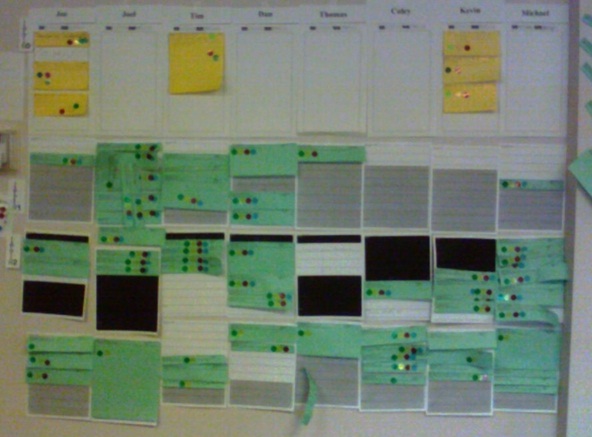On my current project, we release every 2 weeks. We do the push to production on Saturday, so we set a deadline of Wednesday night for everything to be developed and tested so that we can have two days for demos and UAT.
I remember a certain Wednesday a couple of months ago where things were chaotic to say the least. We looked at the board on Wednesday in the early afternoon and there were 20 items where testing was not complete. We were running around trying to make sure that everything got tested. The entire development team was helping out with testing. Many people stayed past dinnertime to get everything done.
This past Wednesday was much different. Everyone was very relaxed. There was only one item on the board that was still being tested. We were all working on getting stuff ready for the next iteration. And oh by the way, one of the QA testers was out on vacation and another one had been moved to another project.
I immediately thought back to that chaotic Wednesday a few months ago and thought about everything that has happened since then. We certainly had come a long way to get to the point where things were much more relaxed. So what happened?
The Three Amigos
Before development can start on a feature, we have a “three amigos” meeting where developers, business analysts, and QA people get together and decide on the acceptance criteria for the feature. This helps us all get on the same page and make sure that we know what we’re building. It also gets the QA team involved very early in the process, so when it comes time for them to manually test the feature, they already know it inside out.
Automating acceptance tests
The outcome of the three amigos meeting is acceptance criteria. Developers take these and automate them whenever possible (we use a combination of unit tests and acceptance tests using SpecFlow). The development workflow now looks something like this:
- Work with the QA team to write out the acceptance tests in SpecFlow
- Develop all of the components needed to make the feature work, writing unit tests along the way
- Try and get the acceptance tests to pass, fixing any problems we find along the way
When I’m working on the “try and get the acceptance tests to pass” phase, I’m going to find pretty much all of the coding errors that we made during development. The development ticket is still marked as “In Development” at this point, which is very important. We all take quality seriously, both QA testers and developers. I’m not going to hand it over to be tested by the QA team until I can get all of the acceptance tests to pass.
Almost no bugs
Because we knew what we were building up front and because we automated pretty much all of the testing, the QA team is finding very few bugs in the new features that we’re developing. One of our testers brought this up in our retrospective this past week and mentioned how they got everything tested so much faster because they weren’t finding bugs, writing up bugs, waiting for bugs to be fixed, and retesting bug fixes.
We had looked at the schedule earlier in the week and we had thought that developers might have to help out with testing because one of the testers was on vacation and they had some items to test that we thought would take a long time. In the end, no developers had to help with testing and testing got done ahead of schedule!
Everyone talks about how bugs are a waste of time, how they slow you down, etc., but it was really cool to see it play out. Yeah, getting those acceptance tests to pass takes a little extra time, but now I can hand a completed feature over to QA and have a good chance of not having any bugs. We had two developers working for a week on the feature that we completed, and we did it with no bugs. Not only that, we have automated acceptance tests that will do our regression testing for us.
Recap
A lot of the changes that we’ve made seem to be relatively minor, but they’ve produced huge dividends. Much of it comes down to discipline, not cutting corners, communicating effectively, and taking pride in your work. I’m really excited about what we’re going to be able to do from here and I expect to have even more stories to tell in the near future.


